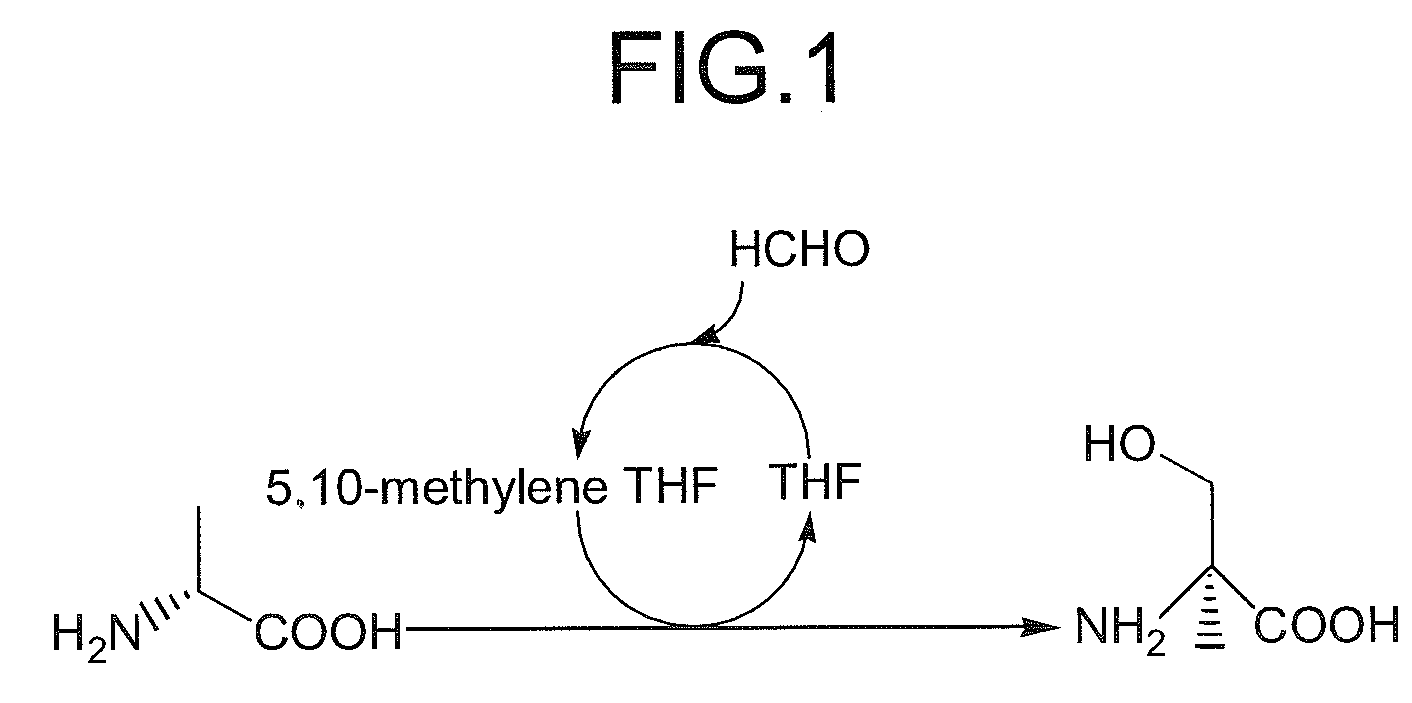Method for producing beta-hydroxy amino acid and enzyme used therefor
a technology of beta-hydroxy amino acid and enzyme, which is applied in the direction of enzymology, organic chemistry, transferases, etc., can solve the problems of not meeting the requirements of practical use and low as 11%, and achieves cost-effectiveness, simple effect, and improved efficiency
- Summary
- Abstract
- Description
- Claims
- Application Information
AI Technical Summary
Benefits of technology
Problems solved by technology
Method used
Image
Examples
example 1
Detection of 2-methylserine Hydroxylmethyl Transferase Activity
[0166]In a nutrient broth agar medium (Difco), microorganisms listed in Table 1 were cultured at 30° C. for 24 hours. A platinum loopful of the resulting cells were inoculated into 3 ml of nutrient broth liquid medium and then cultured at 30° C. for 24 hours, with 120 reciprocations / minute. 0.15 ml of the resulting cultured solution was inoculated into 3 ml of nutrient broth liquid medium containing 0.2% α-methyl-DL-serine and cultured at 30° C. for 24 hours with 120 reciprocations / minute.
[0167]After cultivation, the cells were centrifuged and then washed twice with an equal volume of 50 mM potassium phosphate buffer (pH7.4) containing 0.1 mM pyridoxal phosphoric acid. 50 M potassium phosphate buffer (pH7.4) containing 0.1 mM pyridoxal phosphoric acid was used to prepare a total amount (0.3 ml) of cell suspension and then the suspension was ultrasonically disrupted at 4° C. The supernatant obtained by centrifugation (16,...
example 2
Purification of 2-methyl Serine Hydroxylmethyl Transferase Derived from the Paracoccus sp. AJ110402 Strain
[0170](1) Preparation of Cell-free Extracted Solution
[0171]Cells of Paracoccus species were cultured in the nutrient broth agar medium (Difco) at 30° C. for 24 hours. The cultured cells were inoculated into 50 ml of nutrient broth liquid medium in a 500 ml Sakaguchi flask and cultured at 30° C. for 24 hours with 120 reciprocations / minute. The resulting cultured solution was inoculated into 2 L of liquid medium containing 0.2% α-methyl-DL-serine, and 0.17% yeast nitrogen base w / o amino acid and ammonium sulfate (pH7.0). 50 ml each of the mixture was dispensed into each of the 500 ml Sakaguchi flasks, and then cultured at 30° C. for 22 hours with 120 reciprocations / minute. The resulting cells were collected by centrifugation (8,000 g, 10 minutes) and washed twice with 25 mM potassium phosphate buffer containing 0.02 mM pyridoxal phosphoric acid (referred to hereinafter as the buff...
example 3
Determination of the Amino Acid Sequence of 2-methyl Serine hydroxylmethyl transferase Derived From the Paracoccus sp. AJ110402 Strain and the Nucleotide Sequence Encoding the Same
[0179]50 pmol of the purified enzyme which had been prepared in Example 2 was electrophoresed in SDS-polyacrylamide, and transferred on a PVDF membrane. The relevant part was put in a protein sequencer to determine 30 amino acids (SEQ ID NO: 1).
[0180]Subsequently, 5 μg of genome DNA derived from the Paracoccus sp. AJ110402 strain was cleaved with PstI (50 U) and then ligated to the PstI cassette of TaKaRa LA PCR in vitro Cloning Kit in accordance with the kit directions. Using the ligated mixture as a template, PCR (94° C.: 30 sec., 47° C.: 2 min., 72° C.: 1 min., 30 cycles) was performed with a cassette primer C1 and a primer HMT_FW1 (SEQ ID NO: 2). Using the PCR reaction solution as a template, the second PCR (94° C.: 30 sec., 55° C.: 2 min., 72° C.: 1 min., 30 cycles) was performed with a cassette prime...
PUM
| Property | Measurement | Unit |
|---|---|---|
| temperature | aaaaa | aaaaa |
| temperature | aaaaa | aaaaa |
| concentration | aaaaa | aaaaa |
Abstract
Description
Claims
Application Information
 Login to View More
Login to View More - R&D
- Intellectual Property
- Life Sciences
- Materials
- Tech Scout
- Unparalleled Data Quality
- Higher Quality Content
- 60% Fewer Hallucinations
Browse by: Latest US Patents, China's latest patents, Technical Efficacy Thesaurus, Application Domain, Technology Topic, Popular Technical Reports.
© 2025 PatSnap. All rights reserved.Legal|Privacy policy|Modern Slavery Act Transparency Statement|Sitemap|About US| Contact US: help@patsnap.com



